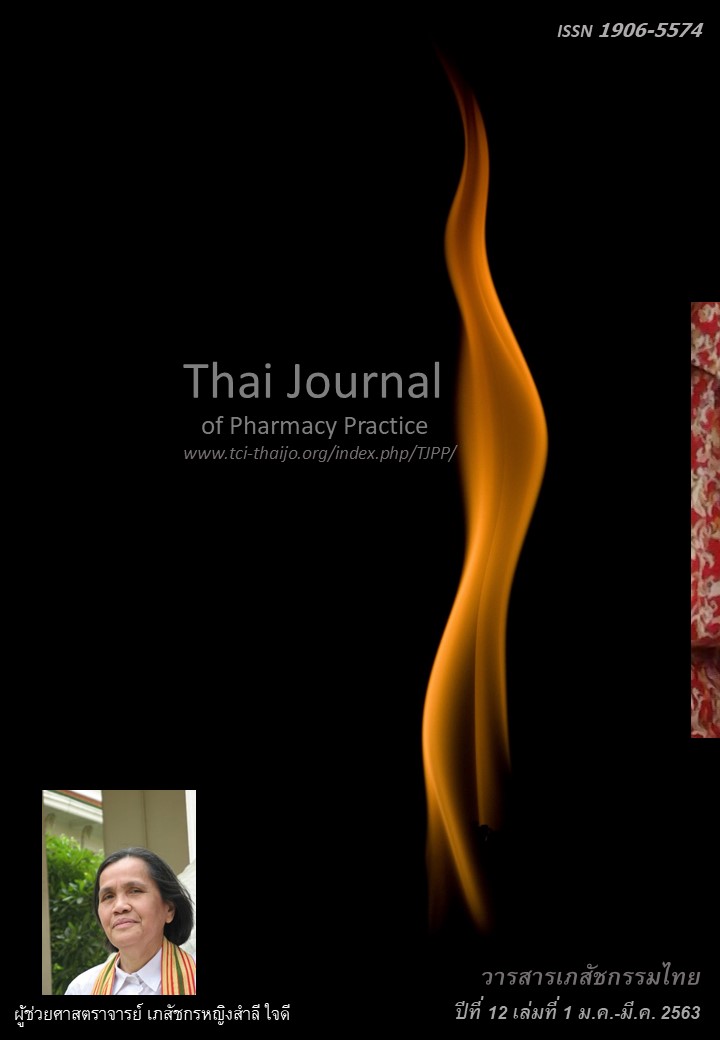การประเมินการใช้ยาต้านการอักเสบที่ไม่ใช่สเตียรอยด์เชิงปริมาณในผู้ป่วย โรคไตเรื้อรัง ณ แผนกผู้ป่วยนอก ในโรงพยาบาลมหาวิทยาลัยแห่งหนึ่ง
Main Article Content
บทคัดย่อ
วัตถุประสงค์: เพื่อประเมินการใช้ยาต้านการอักเสบที่ไม่ใช่สเตียรอยด์ (non-steroidal anti-inflammatory drugs; NSAIDs) เชิงปริมาณในผู้ป่วยโรคไตเรื้อรังของแผนกผู้ป่วยนอก ณ โรงพยาบาลมหาวิทยาลัยแห่งหนึ่ง วิธีการ: การวิจัยนี้เป็นการศึกษาเชิงพรรณนาย้อนหลังในผู้ป่วยโรคไตเรื้อรังที่ได้รับ NSAIDs เป็นครั้งแรกจากโรงพยาบาลระหว่างวันที่ 1 มกราคม – 31 ธันวาคม พ.ศ. 2557 โดยเก็บข้อมูลการใช้ยา NSAIDs จากฐานข้อมูลของโรงพยาบาลร่วมกับการทบทวนเวชระเบียน ผลการวิจัย: ผู้ป่วยโรคไตเรื้อรังในแผนกผู้ป่วยนอกของโรงพยาบาลร้อยละ 12.27 ได้รับ NSAIDs และผู้ป่วยโรคไตเรื้อรังระยะ 3-5 ร้อยละ 11.63 ได้รับ NSAIDs ซึ่งมากกว่าค่าเป้าหมายที่กำหนดไว้ในโครงการโรงพยาบาลส่งเสริมการใช้ยาอย่างสมเหตุผลว่าต้องไม่เกินร้อยละ 10.0 ผู้ป่วยโรคไตเรื้อรังที่ได้รับยา NSAIDs ครั้งแรกจากโรงพยาบาลในแผนกผู้ป่วยนอกมีจำนวน 353 ราย ส่วนใหญ่มีอายุ 65 ปี ขึ้นไป (ร้อยละ 67.14) เป็นเพศหญิง (ร้อยละ 52.12) และเป็นผู้ป่วยโรคไตเรื้อรังระยะที่ 3 มากที่สุด (ร้อยละ 79.60) ชนิดยา NSAIDs ที่แพทย์สั่งใช้มากที่สุด 3 อันดับแรก คือ etoricoxib, naproxen และ celecoxib (ร้อยละ 27.18, 20.77 และ 18.46 ตามลำดับ) แผนกตรวจที่สั่งยามากที่สุด คือ ออร์โธปิดิกส์ อายุรกรรม และศัลยกรรม (ร้อยละ 37.77, 25.27 และ 13.83 ตามลำดับ) โดยมีข้อบ่งใช้เพื่อบรรเทาอาการปวดกระดูกและข้อ ปวดกล้ามเนื้อ และการปวดที่ไม่ได้ระบุสาเหตุ ผู้ป่วยส่วนใหญ่ได้รับยาครั้งเดียว (ร้อยละ 71.95) คิดเป็นจำนวนครั้งที่ผู้ป่วยได้รับยาเฉลี่ยเท่ากับ 1.41 ครั้งต่อรายต่อปี การสั่งใช้ยา NSAIDs ในผู้ป่วยโรคไตเรื้อรังส่วนใหญ่เป็นยากลุ่ม selective cyclooxygenase (COX) 2 inhibitors (ร้อยละ 57.69) และผู้ป่วยร้อยละ 30.59 ได้รับ NSAIDs ต่อเนื่องมากกว่า 14 วัน นอกจากนี้ชนิดยา NSAIDs ที่มีการสั่งใช้ และระยะเวลาการใช้ยาไม่ขึ้นกับระยะของโรคไต สรุป: การใช้ NSAIDs ในผู้ป่วยโรคไตเรื้อรัง ณ แผนกผู้ป่วยนอกมีปริมาณสูงกว่าค่าเป้าหมายที่กำหนดตามโครงการโรงพยาบาลส่งเสริมการใช้ยาอย่างสมเหตุผลและยังพบการใช้ยาต่อเนื่องระยะยาวในผู้ป่วยบางราย การประเมินการใช้ยาเชิงปริมาณทำให้ทราบสถานการณ์ที่แท้จริงของการใช้ยากลุ่ม NSAIDs ในผู้ป่วยโรคไตเรื้อรัง เพื่อเป็นข้อมูลในการหามาตรการส่งเสริมการใช้ยาให้สมเหตุผลต่อไป
Article Details
ผลการวิจัยและความคิดเห็นที่ปรากฏในบทความถือเป็นความคิดเห็นและอยู่ในความรับผิดชอบของผู้นิพนธ์ มิใช่ความเห็นหรือความรับผิดชอบของกองบรรณาธิการ หรือคณะเภสัชศาสตร์ มหาวิทยาลัยสงขลานครินทร์ ทั้งนี้ไม่รวมความผิดพลาดอันเกิดจากการพิมพ์ บทความที่ได้รับการเผยแพร่โดยวารสารเภสัชกรรมไทยถือเป็นสิทธิ์ของวารสารฯ
เอกสารอ้างอิง
2. United States Renal Data System. 2017 USRDS chapter 6: health care expenditures for persons with CKD. Am J Kidney Dis. 2018;71:S117-S36.
3. Keith DS, Nichols GA, Gullion CM, Brown J, Smith DH. Longitudinal follow-up and outcomes among a population with chronic kidney disease in a large managed care organization. Arch Intern Med. 2004;164:659-63.
4. Obi Y, Kimura T, Nagasawa Y, Yamamoto R, Yasuda K, Sasaki K, et al. Impact of age and overt proteinuria on outcomes of stage 3 to 5 chronic kidney disease in a referred cohort. Clin J Am Soc Nephro. 2010;5:1558-65.
5. Hill NR, Fatoba ST, Oke JL, Hirst JA, O'Callaghan CA, Lasserson DS, et al. Global prevalence of chronic kidney disease - a systematic review and meta-analysis. PLoS One. 2016;11:e0148765.
6. Centers for Disease Control and Prevention. Chronic kidney disease surveillance system-United States [online]. 2018 [cited Mar 2, 2018]. Available from: www.cdc.gov/ckd.
7. Ingsathit A, Thakkinstian A, Chaiprasert A, Sangthawan P, Gojaseni P, Kiattisunthorn K, et al. Prevalence and risk factors of chronic kidney disease in the Thai adult population: Thai SEEK study. Nephrol Dial Transplant. 2010;25:1567-75.
8. Rational drug use subcommittee. Rational drug use hospital manual. Nonthaburi: The Agricultural Cooperative Federation of Thailand; 2015.
9. Horl WH. Nonsteroidal anti-inflammatory drugs and the kidney. Pharmaceuticals. 2010;3:2291-321.
10. Koncicki HM, Unruh M, Schell JO. Pain management in CKD: a guide for nephrology providers. Am J Kidney Dis. 2017;69:451-60.
11. World Health Organization. Drug and therapeutics committees-a practical guide [online]. 2003 [cited Dec 6, 2017]. Available from: apps.who.int/medicine docs/pdf/s4882e/s4882e.pdf.
12. Nderitu P, Doos L, Jones PW, Davies SJ, Kadam UT. Non-steroidal anti-inflammatory drugs and chronic kidney disease progression: a systematic review. Fam Pract. 2013;30:247-55.
13. Plantinga L, Grubbs V, Sarkar U, Hsu CY, Hedgeman E, Robinson B, et al. Nonsteroidal anti-inflammatory drug use among persons with chronic kidney disease in the United States. Ann Fam Med. 2011;9:423-30.
14. Heleniak Z, Cieplinska M, Szychlinski T, Rychter D, Jagodzinska K, Klos A, et al. Nonsteroidal anti- inflammatory drug use in patients with chronic kidney disease. J Nephrol. 2017;30:781-6.
15. Adams RJ, Appleton SL, Gill TK, Taylor AW, Wilson DH, Hill CL. Cause for concern in the use of non-steroidal anti-inflammatory medications in the community-a population-based study. BMC Fam Pract. 2011;12:70.
16. Ingrasciotta Y, Sultana J, Giorgianni F, Caputi AP, Arcoraci V, Tari DU, et al. The burden of nephrotoxic drug prescriptions in patients with chronic kidney disease: a retrospective population-based study in Southern Italy. PloS one. 2014;9:e89072.
17. Davison SN, Koncicki H, Brennan F. Pain in chronic kidney disease: a scoping review. Semin Dialysis. 2014;27:188-204.
18. Pham PC, Khaing K, Sievers TM, Pham PM, Miller JM, Pham SV, et al. 2017 update on pain manage ment in patients with chronic kidney disease. Clin Kidney J. 2017;10:688-97.
19. Chou CI, Shih CJ, Chen YT, Ou SM, Yang CY, Kuo SC, et al. Adverse Effects of oral nonselective and cyclooxygenase-2-selective NSAIDs on hospitaliza- tion for acute kidney injury: a nested case-control cohort study. Medicine. 2016;95:e2645.
20. Ungprasert P, Cheungpasitporn W, Crowson CS, Matteson EL. Individual non-steroidal anti-inflammatory drugs and risk of acute kidney injury: a systematic review and meta-analysis of observa- tional studies. Euro J Intern Med. 2015;26:285-91.
21. Trelle S, Reichenbach S, Wandel S, Hildebrand P, Tschannen B, Villiger PM, et al. Cardiovascular safety of non-steroidal anti-inflammatory drugs: network meta-analysis. BMJ. 2011;342:c7086.
22. Fischer MA, Schneeweiss S, Avorn J, Solomon DH. Medicaid prior-authorization programs and the use of cyclooxygenase-2 inhibitors. New Engl J Med. 2004;351:2187-94.
23. Marshall DA, Willison DJ, Grootendorst P, LeLorier J, Maclure M, Kulin NA, et al. The effects of coxib formulary restrictions on analgesic use and cost: Regional evidence from Canada. Health Policy. 2007;84:1-13.
24. Wei L, MacDonald TM, Jennings C, Sheng X, Flynn RW, Murphy MJ. Estimated GFR reporting is associated with decreased nonsteroidal anti-inflammatory drug prescribing and increased renal function. Kidney Int. 2013;84:174-8.


